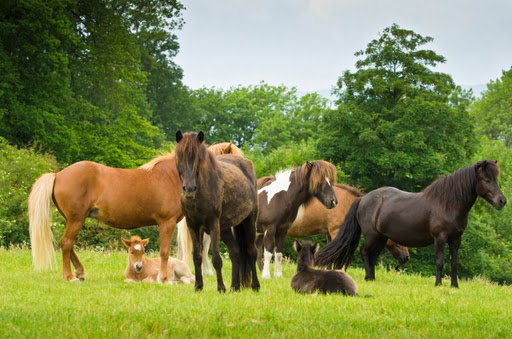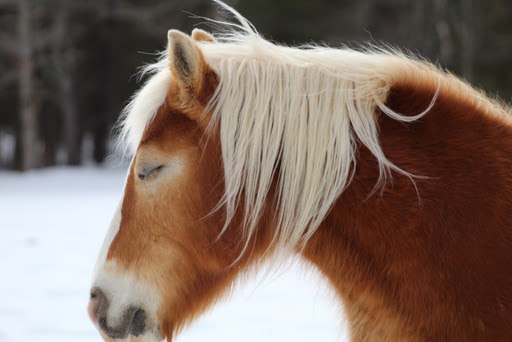Horses belong to a small group of animals that have the ability to sleep while standing up. They do this so that they can quickly run away from any danger, such as a predator attack. However, horses are also able to sleep lying down!
Horses are magnificent creatures. If you have the opportunity to spend a day or two observing a horse, you may notice that in the middle of the day, while the sun is shining brightly, the horse may doze off… while still standing. Its eyes are closed and its head is slightly bowed down. It seems like the horse has entered its own dreamland. After a few minutes, it opens its eyes and returns to reality.
This behavior has fascinated horse breeders and sleep researchers. They wonder why horses sleep while standing up and how they manage to do so without falling over.
 Horse sleeping in a stable. (Photo Credit: twenty20)
Horse sleeping in a stable. (Photo Credit: twenty20)
How Do Horses Sleep
Horses do sleep while standing up, but there is more to the story. Broadly speaking, there are two types of sleep: slow wave sleep (SWS) and REM sleep (also known as paradoxical sleep).
Like many other mammals, horses also lie down and curl up to get a deep sleep when they need it. This is most commonly observed at night when it is dark and the temperature is cooler. This is the deeper REM sleep. The horse’s muscles relax and its brain waves change to provide complete rest. This sleep can last for around 2 to 3 hours, or even just a few minutes, depending on the horse and its surroundings.
 Horses lying down and sleeping. (Photo Credit: twenty20)
Horses lying down and sleeping. (Photo Credit: twenty20)
Slow wave sleep, as the name suggests, is characterized by slow and regular brain waves. Although it is called “slow,” it is actually a shallow form of sleep, similar to briefly dozing off. Horses may take these naps to fulfill their required sleep quota. Just like humans are recommended to have 6 to 8 hours of sleep per day, horses need about 2 to 5 hours of sleep per day.
Horses take their slow wave sleep in short bursts during the middle of the day, similar to an overworked employee in a corporate job with impending deadlines and a large amount of student debt. This is when their unique standing behavior comes into play.
Horses take their mid-day naps while standing up!
Why Horses Sleep Standing Up
In the wild, horses are at risk of being attacked by predators. Sleeping while lying down, even if it is just slow wave sleep, would increase the chances of being caught by predators. Even a split second can make a difference between life and death. Sleeping while standing allows horses to rest while still being able to quickly escape from danger.
 Horse sleeping. (Photo Credit: twenty20)
Horse sleeping. (Photo Credit: twenty20)
In a herd, not all horses sleep at the same time. One or two horses remain awake to watch out for potential predators or any signs of danger. Constant vigilance is necessary.
In a stable, there is not much risk of a meat-eating animal, but the behavior has continued.
Why Horses Sleep Standing Up
When sleep takes over, the muscles relax and become limp. Standing up requires active effort from the muscles in the entire body, not just the legs to support oneself, but also the muscles in the rest of the body to maintain balance and prevent falling over.
The Horse’s Stay Apparatus
However, the horse’s body has a feature that allows it to sleep while standing with minimal effort: the stay apparatus.
The stay apparatus is a collection of muscles, tendons, and ligaments in the hind legs of the horse that enable it to stand without continuous effort.
When horses start to doze off, they activate the stay apparatus by bending one of their hind legs at the knee and “locking” it. The other three legs bear the weight of the horse as it snoozes. After some time, the horse will shift its weight to another leg to prevent fatigue.
Do Other Animals Sleep Standing Up?
Horses are not the only animals that have short periods of sleep and a vertical sleeping position. They are part of a small group of animals that can sleep while standing. Other mammals, such as giraffes, elephants, and camels, have a similar stay apparatus that allows them to sleep while standing. Many birds also sleep upright, and some even sleep on one leg! The most well-known example is the flamingo, but many other birds use a unique perching mechanism to sleep on branches without falling off.
A Final Word
Researchers study these unique sleeping patterns to gain a deeper understanding of the purpose of sleep. Although we know a lot about the effects of sleep on the body (from studying the consequences of sleep deprivation), there are still fundamental questions about why and how sleep evolved that remain to be answered!
